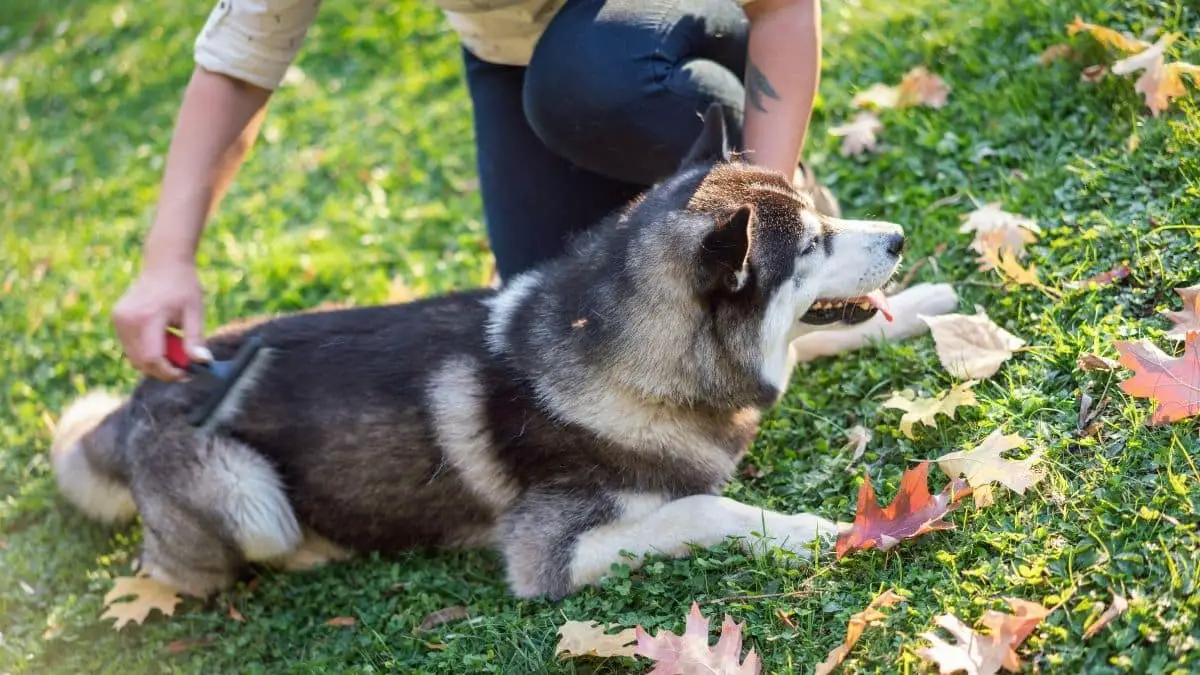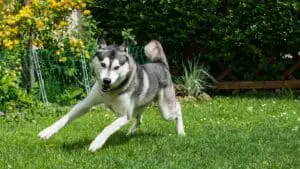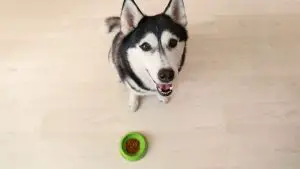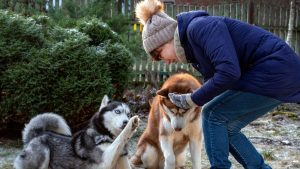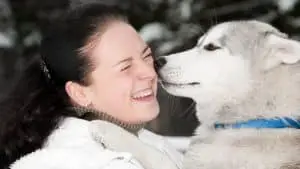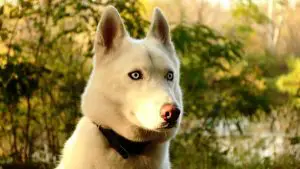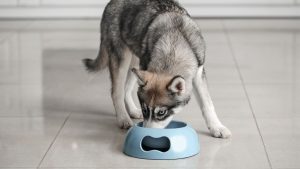How To Groom A Siberian Husky? 5 Things You Should Know
Siberian Huskies are noted for their thick, luscious coats, which traditionally played an important role in keeping them warm in their cold native climates. Made up of two layers – a dense undercoat and a longer top coat – a Siberian Husky’s coat can keep it warm in freezing temperatures as low as -76°F.
At first, the upkeep of a Siberian Husky’s coat might seem complex and time-intensive, but grooming your Husky is actually a relatively easy and straightforward process. Beyond regular weekly brushings, Siberian Huskies really don’t require very much grooming. Your Husky’s undercoat may require a bit of extra attention during the shedding season, but otherwise, Siberian Huskies are considered to be fairly low maintenance dogs.
By investing in a few vital tools and understanding a few key brushing techniques, you are already halfway to having a well-groomed, happy Siberian Husky. While there are a few other aspects of grooming, such as bathing and nail clipping, that you will need to familiarize yourself with, these will only need to be done relatively infrequently.
Table of Contents
What makes a Siberian Husky’s coat so special?
As the name might suggest, Siberian Huskies originated from the far northeastern areas of Asia, in regions that would be commonly classified as Siberia today. They were brought over to America in the 20th Century when Alaskans noted their suitability for the harsh, freezing climate in Alaska.
Siberian Huskies are able to thrive in environments such as Alaska and Siberia because of the unique nature of their double coats.
In basic terms, a double coat means that Siberian Huskies have two layers of fur – a downy, insulating undercoat, and a thicker, protective topcoat.
The undercoat
The undercoat of a Siberian Husky is its main protection against their freezing native climates. The thick, fluffy hairs of the undercoat typically have a crimped appearance, which helps to retain heat and keep your Siberian Husky warm.
Siberian Huskies will shed their undercoat twice a year, usually during spring and fall. This process, which is also known as ‘blowing the coat’, is similar in principle to the way a snake sheds its skin; Siberian Huskies need to shed their old undercoats so that a new undercoat can grow.
Siberian Huskies will usually have a much thinner, or even a non-existent undercoat during the summer months to help them keep cool. Their thicker winter undercoat will have all the classic warm, woolly trademarks that make Siberian Huskies uniquely suited to very cold climates.
The topcoat
The hairs in a Siberian Husky’s topcoat are known as guard hairs. They act as a protective layer for the skin and the undercoat. The long, straight hairs of this coat repel water, ice, and snow, block UV rays and allow the Husky to both keep cool in warm weather and stay warm in cool weather.
Similar to most dogs, the topcoat of Siberian Husky sheds gradually, year-round.
Tools for grooming a Siberian Husky
Given the difference in composition of a Siberian Husky’s two coats, as well as the different roles that each coat plays, it is perhaps not surprising to learn that the undercoat and topcoat require different brushes and different brushing techniques.
When grooming your Siberian Husky’s undercoat, you will need to use a toothed comb, also known as an undercoat rake (click here to see the best undercoat rakes).. These wide-toothed combs are important grooming tools that help to keep the hairs in your Siberian Husky’s undercoat free from matting and clumping.
The topcoat of a Siberian Husky needs to be groomed using a slicker brush. These brushes are paddle-like brushes that will help smooth loose hairs and detangle your husky’s long guard hairs. The slicker brush will also help remove dead skin cells and dander that can otherwise become trapped.
While it might be tempting to use the ever-popular FURminator on your Siberian Husky, especially during shedding season, the use of this particular grooming tool is contentious among Husky owners.
The reason for this is that the FURminator acts on a Husky’s coat much in the same way that a set of shears acts on a sheep’s wool. In effect, you are not brushing out your husky’s coat, but rather cutting it. This is considered an unnecessary step and can even be seen as having a negative impact on the natural shedding process.
Other grooming items that are worth investing in include a good, strong set of nail clippers, a high-quality pet shampoo, and a hairdryer. Although Siberian Huskies may only need to take baths very infrequently, it is wise to ensure that you have the right tools and products ready to go in case of a muddy, messy emergency!
How to Groom a Siberian Husky
Once you have your various brushes and tools, it’s time to get familiar with the correct ways to use them.
You should always begin grooming your Siberian Husky by using the undercoat rake. This will help break up any tough, underlying matts in your Husky’s fur, and will make the grooming process a much easier and simpler task.
Using the undercoat rake, brush against the direction of hair growth. In other words, brush away from the tail towards the head. The long, wide-toothed comb of the undercoat rake will gently prise apart any mats and clumps of fur, and can easily penetrate below the long, straight hair of the top coat.
The slicker brush can be used to smooth and detangle the topcoat and should be used by making firm strokes in the direction of your Husky’s hair growth, from head to tail.
The slicker brush can also be used on your Husky’s paws. During the summer months, when they don’t require protection from ice and snow, you may even wish to trim the long hair between your Husky’s toes. This can be done using trimming scissors – just be careful and ensure you have a firm grasp on your Husky’s paws to stop them from slipping.
If you find that there are any tough clumps or mats of fur during the brushing process, you can try and loosen them using a little pet shampoo or conditioner.
How often should I brush my Siberian Husky?
At a minimum, you should aim to brush your Siberian Husky at least once a week. This will prevent the formation of any hard to manage clumps and mats and will keep your Siberian Husky looking shiny and healthy.
During the times of the year in which your husky is blowing its coat, you may need to increase the frequency of your grooming sessions to two or three times a week. This will help your Husky to shed their undercoat effectively, and will also help you control the amount of fur in your home!
Should I trim my Siberian Husky’s fur?
You do not need to shave or trim your Siberian Husky’s fur, even in summer. In fact, shaving your Siberian Husky may prove harmful.
The long, straight guard hairs that make up a Siberian Husky’s topcoat act to keep your Husky cool during the warmer months. If your Husky has shed it’s warm winter undercoat (with the aid of your careful brushing!), then they should be able to stay cool, even on hot days.
Additionally, Siberian Huskies do not have pigmentation on their skin. Instead, their topcoat helps shield them against harmful UV rays. Shaving their topcoat will expose them to these rays and put them at risk of sunburn.
If you must trim your Husky, the trimming should be very minimal and should be left to professional groomers, experienced in caring for Siberian Huskies.
Nail clipping for your Siberian Husky
Keeping your Siberian Huskies nails at a short, manageable length is an important piece of grooming best practice. Not only will it make your Siberian Husky more comfortable, but it will also prevent any painful and avoidable issues that can occur as a result of overgrown nails.
When clipping your Siberian Husky’s nails, make sure they are lying still and can not move or wriggle around. It is best to get someone to help you with this task, as it can sometimes be difficult to restrain a wriggling Husky!
Try to avoid cutting too close to the quick when trimming your dog’s nails. This can be harder to do if your Husky has dark claws, as the tissue and blood vessels that make up the quick are difficult to see.
Bathing your Siberian Husky
Unlike many other dog breeds, Siberian Huskies do not require frequent baths. Unless you are planning to show your Siberian Husky competitively, you may even be able to get away with bathing your Siberian Husky only a few times a year!
One thing to keep in mind when bathing Siberian Huskies is that their thick, double coat tends to retain leftover shampoo and conditioner if not rinsed thoroughly. To avoid this, ensure that you thoroughly rinse and dry your Siberian Husky after bathing, and work through their fur with both an undercoat rake and a slicker brush.
As their coats are so thick, you can use a hairdryer to ensure that your Siberian Husky is thoroughly dried after a bath. It is best to start using the hairdryer while your Husky is still young so that they become accustomed to it.
Cleaning up after grooming your Siberian Husky
As any Siberian Husky owner will tell you, the fur will quite literally fly when it comes to grooming a Husky!
It is almost impossible to stop the spread of the hair and fur of your Siberian Husky, particularly when it comes to grooming time and during the shedding season.
One way to minimize the amount of dog hair in your home is to conduct all your grooming outdoors. You will still have tufts of fur to clean up once you are finished grooming, but at least you won’t be cleaning them out of your couch or carpet!
If you are going to take the plunge and become the proud owner of a Siberian Husky, it is worthwhile investing in a high-quality vacuum cleaner with a HEPA filter. This filter will help pick up tiny bits of hair and fur, as well as any dander that might be lying around your home.
Grooming your Siberian Husky: the final verdict
For a dog breed that has a thick, double coat and which undergoes a biannual shed, grooming and looking after a Siberian Husky is a relatively easy and low-maintenance task.
You will need to set aside some time every week to give your Husky a thorough brushing with the proper tools. Invest in a robust, good quality undercoat rake and slicker brush, as they will last longer and perform better.
Remember which direction you need to groom each coat: the undercoat needs to be brushed from back to front, and the topcoat gets brushed from top to bottom.
You may find yourself dreading the spring and fall months when your Siberian Husky sheds its undercoat for three weeks, but it’s easy to stay on top of the process by brushing your Husky a little more often (and by investing in a good vacuum cleaner!).
Try and wash your Siberian Husky as infrequently as possible. Huskies tend to produce a lot less natural oil than other dog breeds, and will typically lick themselves clean in most circumstances.
If your Husky’s fur begins to matt quite badly – or they decide to take a dip in a muddy puddle – you can bathe them, but ensure to rinse and dry your Siberian Husky thoroughly after doing so.
One of the most important parts of being a dog owner is properly looking after your furry friend. Owning a Siberian Husky – or any pet for that matter – is a commitment. Regular brushing and grooming is a great way to bond with your Husky. Make sure that you invest in the best tools and set aside the time every week to engage in this important ritual, and show your husky how much you love them!

